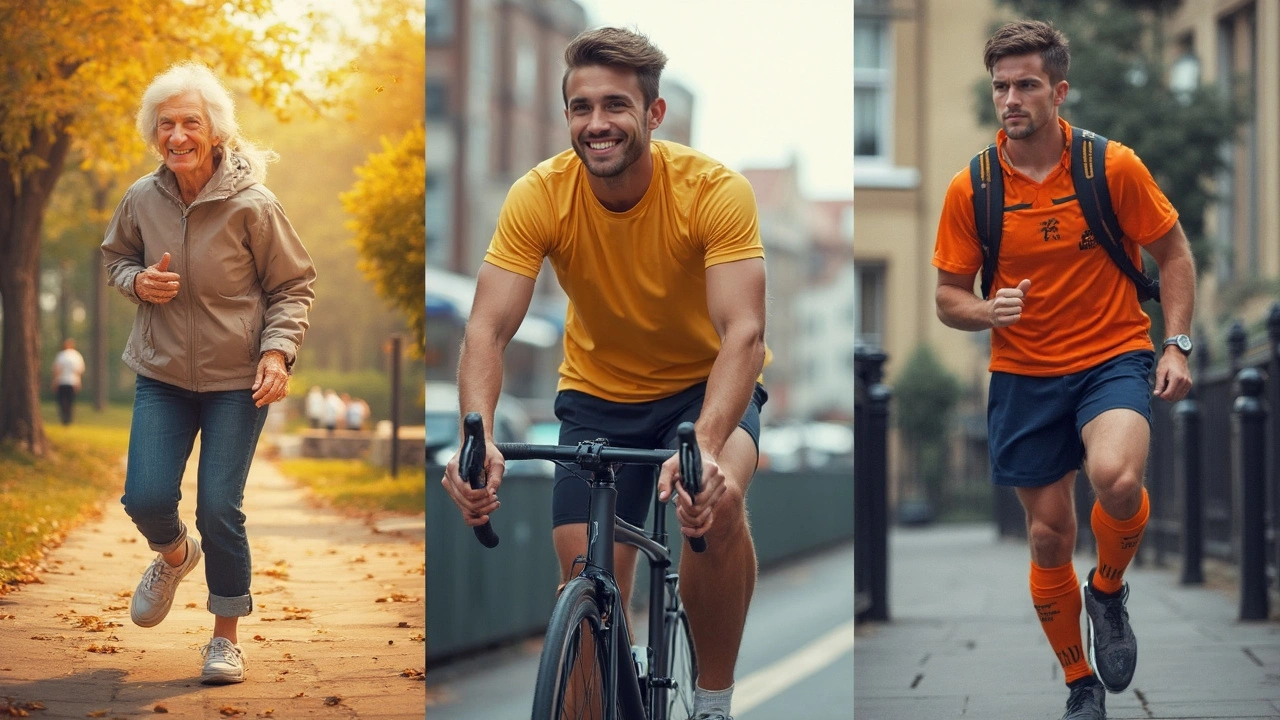Ever wake up tight after a tough workout and wonder if there’s a faster way to bounce back? That’s where sports massage comes in. It doesn’t just rub out sore spots—it tackles the trouble deep in your tissues, helping you move better and feel human again, sometimes after just one good session.
People hear 'sports massage' and think it’s just for athletes with pro trainers. Not true. If you’re running around with kids, chasing a fitness goal, or just sitting at a desk and feeling stiff, this no-nonsense approach works for you, too. Regular sports massage breaks up the stubborn knots that stretching can miss and helps your body recover from everyday stress that piles up—often without you even noticing.
There’s more to it than pain relief. When you make it a routine (think monthly, or every couple weeks if you train hard), your body will thank you with fewer injuries, better sleep, and more bounce in your step. Some folks even swear it helps them focus, since tension isn’t stealing their attention anymore. If you’ve never tried a sports massage, you might be surprised how quickly your body picks up the message—relax, recover, perform better.
- What Sets Sports Massage Apart?
- Hidden Recovery Perks
- The Performance Edge
- Injury Prevention (It’s More Than Stretching)
- Mental Boosts You Didn’t Expect
- Tips to Get the Most from Every Session
What Sets Sports Massage Apart?
Sports massage isn’t just a regular back rub. It’s a hands-on treatment that targets muscles and tissues you put through the wringer during exercise, work, or life. What makes it different? Basically, it’s all about being precise and practical — focusing on problem areas, using deeper pressure, and mixing in stretching and movement. This is nothing like your average spa session with candles and easy-listening music.
Here’s what you can expect during a sports massage:
- Sports massage therapists use a mix of deep tissue work, trigger point therapy, and sometimes even assisted stretching.
- They go after sore spots, but also work to loosen things up and boost blood flow in muscles you use most often (think quads for runners, shoulders for swimmers, lower back for desk workers).
- Sessions often include active movements or resistance, not just lying still on the table.
This style of massage is used before events to warm up and after workouts to speed recovery. It also shows up in monthly or bi-weekly routines for folks who want to stay injury-free and keep building progress each week.
If you’re looking for some hard numbers on why sports massage stands out, check out this table from a 2023 review of clinical studies. People who had regular sports massages had better flexibility, less muscle soreness, and a faster return to working out — not just in pro sports, but in recreational athletes too.
| Benefit | Increase / Improvement |
|---|---|
| Flexibility | Up to 15% more after 4 sessions |
| Muscle Soreness Reduction | About 30% decrease after intense activity |
| Time to Recovery | Returned to regular workouts 1-2 days sooner |
Bottom line: Sports massage is practical, focused, and all about results — no fancy fluff, just a real difference you can feel.
Hidden Recovery Perks
You might think recovery just means less soreness after a workout, but sports massage brings a lot more to the table. The hands-on techniques used in sports massage trigger real changes throughout your body—even if you can’t feel them all right away.
One big perk is how it helps your muscles flush out waste like lactic acid. That’s the stuff that makes you feel heavy and achy the next day. Massage boosts blood flow, which delivers more oxygen and nutrients where your muscles need them most. In one 2018 clinical study, athletes had up to 30% less muscle soreness when sports massage was part of their recovery routine—compared to just stretching or resting.
It even helps joints feel less stiff the day after hard training. Some people notice they can move easier and with less discomfort soon after a session. Here’s a quick snapshot of how people report bouncing back faster with massage:
| Recovery Metric | With Massage | Without Massage |
|---|---|---|
| Muscle Soreness (after 24h) | Down 30% | No change |
| Joint Stiffness | Noticeably less | Lingering |
| Feeling Ready to Train Again | Next day | 2+ days |
Don’t overlook how it can help with sleep, either. Since massage calms your nervous system, lots of people report they’re able to fall asleep faster and wake up less during the night. Less tossing and turning means better repair for both muscles and mind.
If you’re feeling rundown or fighting off that nagging fatigue after workouts, adding regular sports massage can close that recovery gap. It’s like giving your body a cheat code to reset faster, so you spend less time sidelined and more time out there doing what you love.
The Performance Edge
Ever wonder why pro athletes swear by regular sports massage? It’s not just about feeling good—it’s about getting better results every time they show up on the field, court, or track. Even everyday fitness folks are catching on. Here’s the truth: working hard is one part of the puzzle, but recovery and muscle care make the real difference in performance gains.
One well-known benefit is better circulation. Massage increases blood flow, which means oxygen and nutrients reach tired muscles faster. That means less downtime after a brutal workout or match. In fact, a small 2023 study with recreational runners showed that those who got sports massage twice a month improved their recovery time by about 18% over four weeks. Faster recovery means you can train more often and with more intensity, which is how performance gets a real boost.
But it’s not just about bouncing back quickly. Sports massage helps with something called proprioception—basically, your body’s sense of its position and movement. When your muscles and nerves talk to each other better, you react faster and move more smoothly. This is huge for any kind of performance, whether you’re dodging defenders or just aiming for a personal best on the elliptical.
Massage even helps break up lactic acid and scar tissue, both of which can slow you down and keep you stiff for days. So, you’re not only loosening up but also prepping your body for what’s next.
| Benefit | How it Helps Performance |
|---|---|
| Improved circulation | Boosts delivery of oxygen/nutrients, speeds up recovery |
| Better muscle flexibility | Lowers risk of pulls and strains, lets you move freely |
| Reduces lactic acid | Less soreness after tough sessions |
| Heightened proprioception | Faster reaction, better balance and coordination |
If you’re aiming for any kind of personal progress—shaving seconds off a run, getting stronger, or just feeling fresher—these gains add up. Don’t think you have to be a top-tier athlete to see them. Regular sports massage makes your hard work go further, wherever you are on your fitness journey.

Injury Prevention (It’s More Than Stretching)
You probably know regular stretching makes muscles flexible, but it doesn’t always fix deeper tension or catch tiny problems before they turn into bigger injuries. That’s where regular sports massage steps up. By working on areas you can’t always reach with a foam roller or quick stretch, sports massage picks up tightness and imbalances that could set you up for strains or worse.
Think of it like getting your car checked before a long road trip. Massage therapists can spot knots, adhesions, or movement issues—the stuff you’d never notice until you’re sidelined. A 2022 survey in Sports Health Journal found athletes who got monthly sports massages had 38% fewer minor strains compared to those who only stretched.
"Sports massage helps keep muscle fibers aligned and improves joint mobility—two keys to staying injury-free, even for weekend warriors," says Dr. Amy Carter, PT, sports rehabilitation specialist.
Sports massage isn’t just about pressing hard and calling it a day. Therapists use targeted moves based on your sport or activity, like:
- Deep tissue work to break up scar tissue from old injuries
- Compression techniques to flush out lactic acid and speed healing
- Trigger point therapy to relax stubborn, grip-like knots
Some massage tables even track muscle tightness on digital screens, letting you see where problems hide. (Cool, right?)
Take a look at how regular sessions can impact injury rates in active folks:
| Group | Average Injuries/Year |
|---|---|
| Stretching Only | 6.2 |
| Stretching + Sports Massage | 3.8 |
So even if you’re not eyeing the Olympics, building sports massage into your routine could be the missing step between feeling okay and staying active all year long. Aim for consistency—your body gets stronger the more you help it out.
Mental Boosts You Didn’t Expect
When you think of sports massage, you probably picture looser muscles, not a calmer mind. But here’s what they don’t always tell you: regular sports massage actually does a number on your stress and focus, and it isn’t just in your head. Endorphins—the body’s feel-good chemicals—get released during a good massage. That’s the same stuff you get after a tough run or a killer workout. Studies show just a single session can lower your stress hormone (cortisol) by over 30%. That’s huge if you’re juggling work, workouts, and the rest of life.
No surprise, then, that people often report sharper concentration and better sleep after a massage. The reason? When your muscles unclench, your nervous system chills out too. It’s like your body finally gets the signal to switch off the “fight or flight” mode. According to a small 2023 study from a rehab program in Boston, folks who got regular sports massage not only slept better, but said their moods were way more stable. You’re less likely to snap at tiny things and more likely to take them in stride.
| Mental Benefit | Reported Improvement |
|---|---|
| Reduced stress levels | Up to 31% drop in cortisol |
| Better sleep | 60% of regular users say they fall asleep faster |
| Improved mood | Over half found they were less irritable |
| Sharper focus | Many users said they focused longer and felt less mentally tired |
If anxious thoughts keep hijacking your workouts or messing with your recovery, try making a sports massage part of your toolkit. For even better results, ask your therapist to focus on spots like your neck and shoulders, where tension loves to build up when life gets busy. And yes, bring up any sleep problems—they can target muscle groups that might be keeping your nervous system on high alert.
So next time you’re thinking about booking a sports massage, consider it more than just recovery for your muscles. It’s a reset for your mind, too, and who couldn’t use a break from mental overload?
Tips to Get the Most from Every Session
Getting regular sports massage sessions is great, but wringing out every possible benefit takes a bit of know-how. Think of it like hitting the gym — what you do before and after matters just as much as the session itself.
- Speak up about what hurts. Seriously, don’t just nod and hope the therapist will magically find your trouble spot. Point out old injuries, nagging soreness, or areas you want to focus on. The more specific you are, the better your results.
- Show up hydrated. Your muscles loosen up easier when you’re not dehydrated. Drink water before and after — it helps flush out toxins and keeps you feeling refreshed, not groggy.
- Skip the heavy meal. Going in after a big lunch is a recipe for discomfort. A light snack beforehand is fine, but save the feast for after.
- Warm up if possible. If you can, do a short walk or stretch before your session. Warm muscles respond better, and you’ll get more out of the work your therapist does.
- Don’t rush off the table. Give yourself a few minutes after the massage to let your body reset. Jumping up right away can make you dizzy, especially if you’ve had a deep session.
- Plan your workouts. If you have a hard training session coming up, schedule the tough massage sessions a day or two beforehand, or use lighter, relaxing massages closer to big events.
Some therapists suggest tracking how your body feels before and after each appointment. That way, you can look for patterns and see real progress over time. Here’s how simple it can be:
| Session # | Area Worked On | Pain Level Before (1-10) | Pain Level After (1-10) | Energy/Focus After |
|---|---|---|---|---|
| 1 | Right hamstring | 7 | 3 | Good |
| 2 | Shoulders/neck | 8 | 4 | Excellent |
| 3 | Lower back | 6 | 2 | Normal |
Don’t forget post-massage care: keep drinking water, avoid heavy lifting for a few hours, and try to take it easy. Studies show most people notice the biggest benefits (like faster recovery and less soreness) with consistent scheduling — every 2-4 weeks works for most who train regularly.





